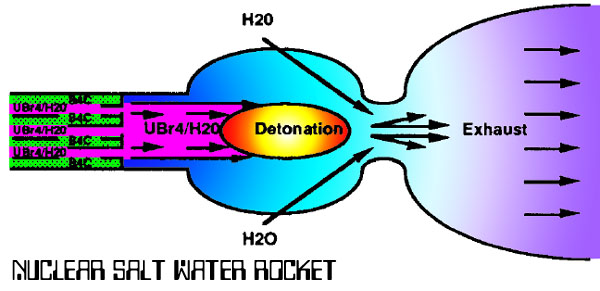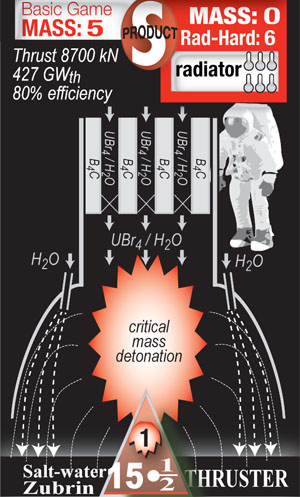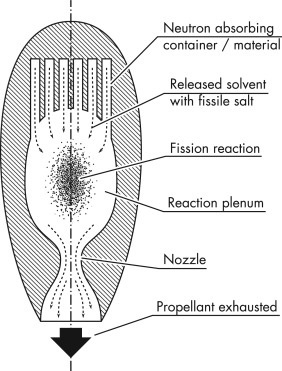A blast from the science fiction past
Posted: Fri Jun 01, 2018 2:14 am
Reading Rocketship Galileo. How's a thorium- zinc nuclear thermal rocket sound? Weren't the late 40s fun?
a discussion forum for Polywell fusion
https://www.talk-polywell.org/bb/
kunkmiester wrote:Reading Rocketship Galileo. How's a thorium- zinc nuclear thermal rocket sound? Weren't the late 40s fun?
In an NSWR the nuclear salt-water would be made to flow through a reaction chamber and out an exhaust nozzle in such a way and at such speeds that critical mass will begin once at the chamber is filled to a certain point, however, the peak neutron flux in the fission reaction would occur outside the vehicle.[1]
https://en.wikipedia.org/wiki/Nuclear_salt-water_rocketDue to their ability to harness the power of what is essentially a continuous nuclear fission explosion, NSWRs would have both very high thrust and very high exhaust velocity, meaning that the rocket would be able to accelerate quickly as well as be extremely efficient in terms of propellant usage. Such an engine being able to produce both high thrust and high ISP is a very rare trait in the rocket world, owing to the possibility to use a low density propellant such as hydrogen.[5] One design would generate 13 meganewtons of thrust at 66 km/s exhaust velocity (compared to ~4.5 km/s exhaust velocity for the best chemical rockets of today).
The design and calculations discussed above are using 20 percent enriched Uranium salts, however, it would be plausible to use another design which would be capable of achieving much higher exhaust velocities (4,700 km/s) and use 2,700 tonnes of highly enriched uranium salts in water to propel a 300 tonne spacecraft up to 3.6% of the speed of light.[1]




A "proper" Orion reference in regards to rocketry, unlike the vast majority I've seen lately."NSWRs share many of the features of Orion propulsion systems, except that NSWRs would generate continuous rather than pulsed thrust and may be workable on much smaller scales than the smallest feasible Orion designs (which are generally large, due to the requirements of the shock-absorber system and the minimum size of efficient nuclear explosives)."[6]
HabEx
The first mission we’ll look at is HabEx, or the Habitable Exoplanet Imaging Mission. This is a spacecraft that will directly photograph planets orbiting other stars. It’ll be targeting all kinds of planets, from hot Jupiters to super Earths, but its primary target will be to photograph Earth-like exoplanets and measure their atmospheres.
Wavelengths of light that can help suggest biospheres. Credit: NASA/JPL
[/i]
In other words, HabEx is going to try and detect signals of life in planets orbiting other stars.
In order to get this done, HabEx needs to block the light from the star, so that much fainter planets nearby can be revealed. It’ll have one and maybe two ways to do this.
The first is using a coronagraph. This is a tiny dot that sits inside the telescope itself, which is positioned in front of the star and blocks its light. The remaining light passing through the telescope comes from fainter objects around the star and can be imaged by the instrument’s sensor.
The telescope has a special deformable mirror that can be tweaked and tuned until the fainter planets come into view.
Here’s an example of a coronagraph in use, on the European Southern Observatory’s Very Large Telescope. The central star is hidden, revealing the dimmer dust disk around it. Here’s a direct image of a brown dwarf orbiting a star.
This infrared image shows the dust ring around the nearby star HR 4796A in the southern constellation of Centaurus. It was one of the first produced by the SPHERE instrument soon after it was installed on ESO’s Very Large Telescope in May 2014. It shows not only the ring itself with great clarity, but also reveals the power of SPHERE to reduce the glare from the very bright star — the key to finding and studying exoplanets in future.
And this is one of the most dramatic videos I think I’ve ever seen, with 4 Jupiter-sized worlds orbiting around the star HR 8799. It’s a bit of a trick, the researchers animated the motion of the planets in between observations, but still, wow.
The second method of blocking the light will be to use a Starshade. This is a completely separate spacecraft that looks like a pinwheel. It flies tens of thousands of kilometers away from the telescope, and when it’s positioned perfectly, it blocks the light from the central star, while allowing light from the planets to leak around the edges.
The trick with a Starshade is those petals, which create a softer edge so the light waves from the fainter planet is less bent. This creates a very dark shadow that should have the best chance at revealing planets.
Artist’s concept of the prototype starshade, a giant structure designed to block the glare of stars so that future space telescopes can take pictures of planets.
Unlike most missions, Starshades like this can be used with any observatory in space. So, Hubble, James Webb or any other observatory could take advantage of this instrument.
We’ve always complained about how we can only see a fraction of the planets out there using the transit or radial velocity method because of how things line up. But with a mission like HabEx, planets can be seen direction, in any configuration.
In addition to this primary mission, HabEx will also be used for a variety of astrophysics, like observing the early Universe, and studying the chemicals of the biggest stars before and after they explode as supernovae.

https://www.cbr.com/harlan-ellison-dies-84/“Susan Ellison has asked me to announce the passing of writer Harlan Ellison, in his sleep, earlier today,” Valada wrote. “For a brief time I was here, and for a brief time, I mattered.”—HE, 1934-2018. Arrangements for a celebration of his life are pending.